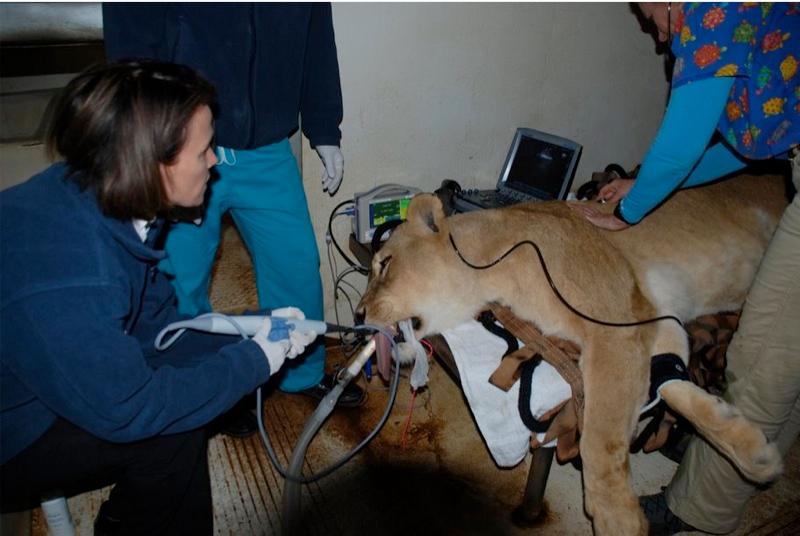Understanding animals could help doctors treat human patients, says UCLA cardiologist
A team at the Los Angeles Zoo of veterinary and human cardiologists and anesthesiologists worked together to treat this lion. (Photo by Zoobiquity).
From eating disorders to fainting, heart attacks to obesity, health problems that afflict humans can often be found in animals as well.
A cardiologist at the University of California, Los Angeles Medical Center says that looking health problems through lens veterinary medicine could help physicians treat humans.
Barbara Natterson-Horowitz is the author of Zoobiquity: The Astonishing Connection Between Human and Animal Health. She became interested in the similarities between human and animal health through her work as a cardiac consultant to the Los Angeles Zoo and as a co-director of UCLA’s Evolutionary Medicine Program. Though there can be some snobbery among physicians about veterinarians, she says, veterinarians have a lot to offer physicians.
“I had this wonderful opportunity to participate as a physician on a medical advisory board of our local zoo. And one of the things that started happening to me was that I became incredibly admiring of these doctors because of the breadth of knowledge they needed to have,” Natterson-Horowitz says.
Veterinarians are trained comparatively, which means for example that they learn not just about the heart but the hearts of many different species, whereas medical doctors only focus on human hearts.
Natterson-Horowitz and her team found that there are barriers to collaborating with veterinarians and animal experts because the fields do not understand each other well and do not have enough opportunities to discuss the similarities in their work.
She tells this story from a day at the zoo: The veterinarian she was working with needed to do an ultrasound on a Tamarin monkey because of concern that the monkey was developing heart failure. When the monkey started falling asleep from the sedation, Natterson-Horowitz crouched down to look into the monkey’s eyes to create a trust bond, something she does out of habit when working with a young patient. But the veterinarian stopped her for fear that the monkey could develop “capture myopathy.”
Natterson-Horowitz had never heard of capture myopathy. She learned that if an animal is scared they can have a surge of adrenaline that poisons the muscles in their body, including their heart, which can be fatal.
Veterinarians have known about this syndrome since the 1950s, Natterson-Horowitz says. But fear-induced or stress-induced heart failure did not reach the human medical world until about 2000 when it was characterized by a group of Japanese cardiologists as Takotsubo cardiomyopathy.
“Veterinarians and wildlife biologists have known about this [syndrome] and had ways of treating it and even preventing it that we humans had no knowledge of and no reason to even think to access the animal literature to find out about,” she says. Bringing veterinary and human medicine closer together could help find “a better way to practice medicine for both animals and humans and ultimately pursue the kind of investigations that can lead to cures to benefit patients of all species,” she says.
Collaboration between the two professions is still in early stages, but there are important perspectives that medical doctors can get from veterinarians. When veterinarians work with overweight animals, for example, they look at the animal’s environment and modify it to make it less “obesogenic.”
“One of the ways the veterinarians will intervene…is they make it harder for an animal to access its food. They actually create these enrichment toys where and animal needs to forage and poke its nose in and bat a ball around just to pull out…whatever the treat is,” she says.
Now, there are some public health experts who are also beginning to consider the obesity epidemic in humans is less about individual control issues and more about environmental concerns, Natterson-Horowitz says.
Zoobiquity will be published in April from Vintage Books.
Every day, reporters and producers at The World are hard at work bringing you human-centered news from across the globe. But we can’t do it without you. We need your support to ensure we can continue this work for another year.
Make a gift today, and you’ll help us unlock a matching gift of $67,000!
